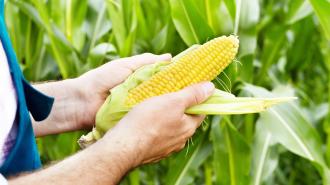Silencing a single gene in corn or rice can increase crop yields by up to 10% — suggesting a straightforward way CRISPR could help us feed a growing population.
The challenge: We’ll need to produce 60% more food by 2050 to meet the needs of Earth’s growing population, according to the United Nations.
We’re already using most of our high quality farmland, though, and climate change could make it harder for farmers to boost crop yields on existing land.
The discovery: More than a third of the calories consumed globally come from corn and rice, and researchers from China and Germany have now found a way to get each ear of corn and stalk of rice to grow more food.
They started by looking for genetic differences between modern corn, which has 14 rows of kernels, and its wild ancestor — teosinte — which has just two rows.
More than a third of the calories consumed globally come from corn and rice.
They discovered a gene that restrains kernel production, via a protein called WD40 (no, not the spray stuff). Using CRISPR, the researchers knocked out the gene, and when they grew the modified plants in field trials, the corn crop yields were 10% greater than in unedited controls.
After discovering a comparable gene in rice, the researchers tried knocking it out, too, and the resulting plants produced 8% more grain in field trials.
This may not sound like much, but it’s an incredible boost from turning off just one gene. Corn has over 30,000 genes, and rice has tens of thousands more.
The future of food: We could knock out these genes in standard varieties of corn and rice to boost crop yields, but the researchers also suggest we could add their newly identified genes to the plants’ wild counterparts, which are less productive but more resistant to climate change.
“You can breed high-yielding, but also more resistant plants, which will be crucial for agriculture in the future.”
Alisdair R. Fernie
We could re-domesticate these wild plants, increasing crops’ genetic diversity and potentially making our food supply more robust, while still growing enough food to feed several billion people.
“We could simply introduce a handful of these domestication genes […] into their wild relatives,” said Alisdair R. Fernie from the Max Planck Institute. “The idea behind this is that you can breed high-yielding, but also more resistant plants, which will be crucial for agriculture in the future.”
We’d love to hear from you! If you have a comment about this article or if you have a tip for a future Freethink story, please email us at tips@freethink.com.
